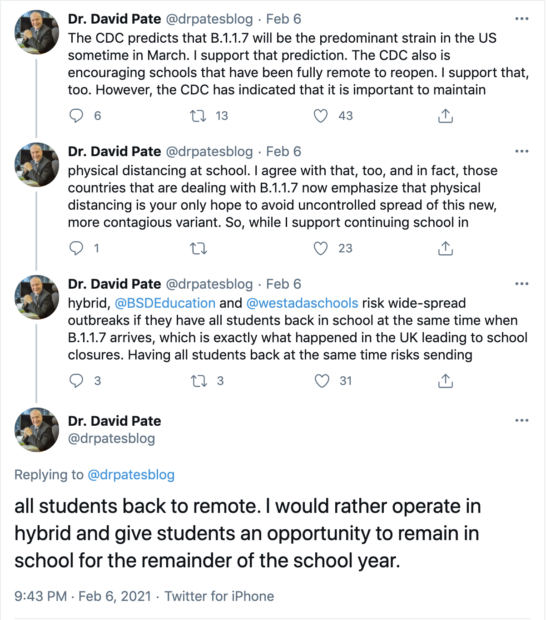Health experts don’t recommend that all Boise School District students go back to in-person learning five days a week. Not yet, at least.
That’s what Central District Health program manager Gina Pannell and hospital executives Kenny Bramwell and Mark Nassir told trustees Monday night, before board members heard from a committee exploring students’ full-time return. Trustees did not approve a move from a hybrid to a full-time learning plan Monday, but will continue to explore the idea. The board called a special meeting for Feb. 18 to consider recommendations for a return to five-day-a-week, in-person learning.
“There’s stress on families, there’s stress on students, there’s stress on teachers,” school board president Dave Wagers said. “…But once again, no perfect answers. I would like time to evaluate classrooms.”
The majority of Idaho’s districts have reopened for full-time, or near full-time, in-person classes. An Idaho Education News review found 115 districts and charter schools operating all in-person and 51 operating in hybrid. Only a couple of Treasure Valley charter schools remained entirely remote.
The openings follow a downward trend in COVID-19 cases across the state, the opening of vaccine access to teachers and Centers for Disease Control research that says schools can operate without widespread COVID-19 transmission when administrators observe safety measures.
Middle and high school students in the Coeur d’Alene school district came back to school four days a week in February, largely because of low case counts in the surrounding community, spokesman Scott Maben said.
“We’re back to where we’re confident that the risk is fairly minimal, especially with continuing to require masks, and whatever impact we’re going to see with immunizations,” Maben said.
Vaccines, physical distancing, case rates, new virus strains and student mental health are all part of the exceedingly complicated arithmetic of reopening that Boise trustees pondered Monday night.
Bringing all students back together cuts down on the space schools have for physical distancing, and could increase the number of students who have to quarantine if a classmate tests positive. A district review found that only 31 percent of classrooms would allow for six feet of space between students if all kids returned full-time. The majority of classrooms would require shrinking distancing closer to three feet.
And while a school district survey indicated that more than 86 percent of teachers intended to get vaccinated, they haven’t completed that process yet. District officials estimate that staff won’t reach peak immunity until the first weeks of March, after they’ve had time to receive two doses of the vaccine.
Idaho is one of only 26 states where teachers currently have access to vaccinations, according to CNN. Gov. Brad Little made teacher vaccines available as early as Jan. 13, before elderly adults could receive them.
But teachers are not the only population vulnerable to potential COVID-19 spread in schools. Pannell, of Central District Health, also raised the importance of vaccinating adults over the age 65, since many students live in intergenerational households and could potentially carry COVID-19 to vulnerable family members.
“It’s critically important those folks are protected,” Pannell said. Vaccinations opened for that age group during the first week of February.

Even with vaccines making the rounds, and falling COVID numbers around Idaho, medical experts are cautious about a full-fledged return to school.
Dr. David Pate — the former CEO of St. Luke’s Health System, who has been advising school districts on pandemic reopening protocols — said new and more contagious variants of the COVID-19 could pose a new risk for schools. He pointed specifically to a variant from the U.K. that could become the predominant strain in the U.S. by March, according to the New York Times.
“Having all students back at the same time risks sending all students back to remote,” if that variant spreads, Pate said on Twitter. “I would rather operate in hybrid and give students an opportunity to remain in school for the remainder of the school year.”
Health experts who spoke with Boise trustees Monday recommended that the district continue to plan for a potential full-time return if Ada County’s COVID case rates keep falling. Ada is one of only five Idaho counties currently considered in the highest risk category for COVID-19 spread.
Trustee Beth Oppenheimer tried to speed up the reopening process with a motion that the district bring pre-K through second-grade students back in two weeks time. She was shot down by members of the board who wanted more time to evaluate classrooms and hear from parents.
The district sent surveys to students, families and parents to collect their opinions around reopening. Trustees will meet on Feb. 18 to review that feedback and continue the reopening discussion.
Data analyst Randy Schrader contributed to this report.
